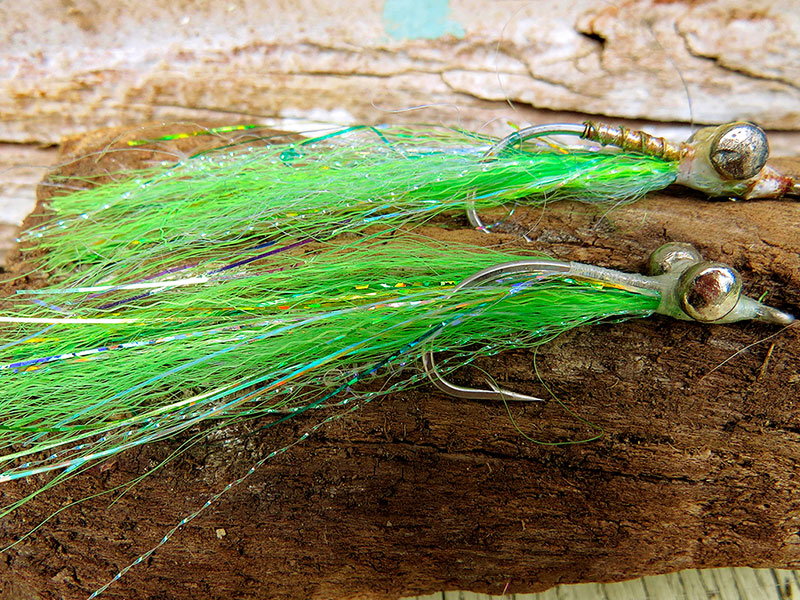Winter fishing tips: new fly-tying ideas
4 min read
The Clouser Minnow fly in colours for kahawai. Don’t overdo the flashy stuff. Photo: Ben Hope
One way to get over the winter months and limited fly fishing for trout or saltwater is to hunker down, read a few books, swap a few e-mails with fishing friends, and tie up some new patterns for the coming spring and summer. But hold on, not so fast. There’s still fishing opportunities, whether for trout or saltwater fish such as kahawai.
A couple of seasons back, down at the river mouth after kahawai with the fly rod, I met fellow angler Sam. He was from Auckland, a skilled caster, and a top fish hunter. We got to chewing the fat about fish and flies, and he mentioned that he had tried the Wairau River with good success, usually at dusk. One evening he had hooked into a series of browns that had entered a side stream that ran off the main river and into a backwater, which, in turn, linked further downstream to the main river.
He landed a couple of respectable browns and been busted in some debris by others, including one that Sam reckoned might have nudged double figures in weight. They were brown trout running upriver from the sea, but it was the fly he used that interested me in particular – a small sombre streamer pattern with dumbbell eyes.
A couple of days later, Sam was upriver on a sunny morning and took a splendid 3kg-plus brown on the little dumbbell pattern. As he explained, the fly was a freshwater version of the Clouser Minnow, a saltwater pattern.
The Clouser Minnow is an American saltwater pattern developed by Bob Clouser. Basically, it is a slim lure pattern with dumbbell eyes that give it faster sinking than an orthodox fly lure. With the dumbbell eyes on the bottom of the fly, it rides with the hook, point up, thus making them less likely to snag. The heavier the dumbbell, the faster the sink rate. Tungsten dumbbells, for instance, sink like a rock and sink fast like a torpedo.
Colour combinations can be tied to suit yourself. For kahawai, chartreuse over white is a good combination. For trout, a dark green or brown over lighter shades of the same, are best. The trick in tying Clouser Minnows is to not overdress them. Keep it sparse and slim.
Read more: Sustainable fishing = better fishing
Read more: Prime time for Taupo River trout
In winter, kahawai seem to move in places such as Tauranga Harbour. Tying up a few Clousers and then getting out on the sheltered waters could be a good pastime in the colder months.
The dumbbell eyes can be bought from tackle shops but there is a novel alternative and a cheap one too.
For lighter dumbbell eyes, particularly freshwater, you can use an old bathroom plug chain, in essence, a series of little beads. Take some pliers to the chain and snip off a pair of beads. These are then tied onto the hook shank, figure of eight style.
For saltwater, you may go as big as 3/0; for freshwater, a size 6 or 8. Naturally, the size of the fly dictates the size dumbbells.
Materials used include:
- Hook: 3/0 to 8
- Dumbbell eyes
- Bucktail in various colours of your choice
- Flashabou or Krystal Flash
Here’s a top tip: don’t overdo the use of glitter, i.e. Flashabou or Krystal Flash.
The Clouser should be a winner as a winter fly when it becomes more necessary to get the fly deeper. In a UK fishing and fly-tying magazine, I read noted fishing writer Charles Jardine detailed a nymph that was simple, lifelike, and gets deep.
He called it the Lead Bug incorporating lead wire.
Based on his fly, I came up with this:
Hook: Grub style size 8–14
Body: lead wire (of gauge to suit hook size) wound evenly around the hook. Colour the lead wire green or brown or whatever with a waterproof felt pen.
Head: Peacock herl with a few hare fur fibres to suggest feelers
With its weight, by virtue of the lead wire, the Lead Bug could be a good winter nymph that will get deep. Because the trout’s metabolic rate slows in cold water temperatures, it needs less food and does not feed so actively.
But they do need some to maintain their body weight. So, they tend to sit deep rather than with a mind and an eye, cocked to the surface.
And because they don’t move so much as in summer feeding style, the nymph has to virtually come to the trout.
A deeply fished nymph is a likely answer and the Lead Caddis in slightly bigger sizes (8 and 10) is a good choice.
For Taupo, in winter, incorporate a bit of colour, particularly orange, as trout are reputedly partial to the odd trout egg rolling down from other spawning fish.
Perhaps an orange felt pen applied to the body or some orange seals fur at the head? And how about with the need to get the nymph deep, if regulations allow, even adding a small-sized split shot or two to just above the fly? If you hook up on the bottom and lose a few nymphs, what the heck? The Lead Bug is so simple that rattling off half a dozen at your fly-tying vice won’t take long.
But if the Lead Bug doesn’t work, try using a Clouser bucktail; fish it slow and deep as a change of tactics.
So don’t shy away from the colder months. These two interesting fly-tying patterns with variations could just be winners.



